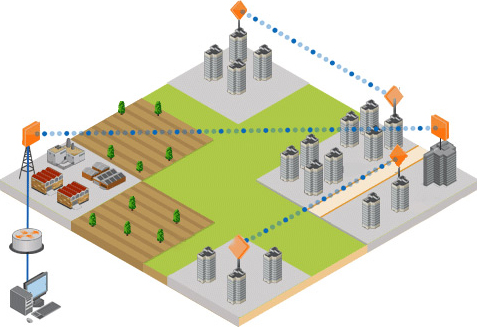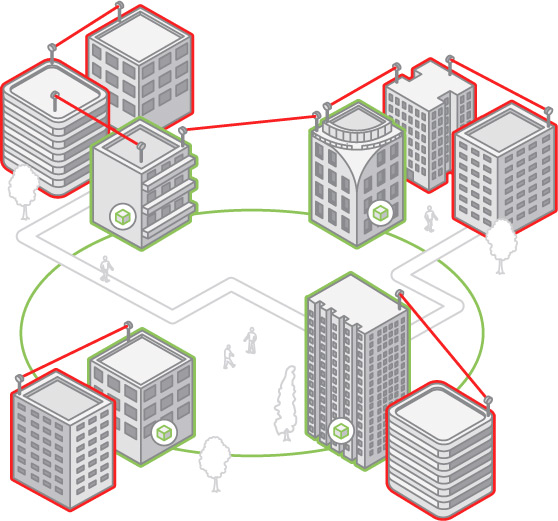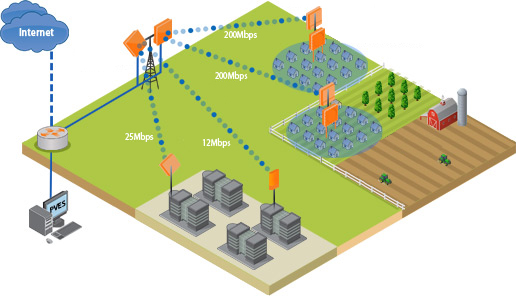An Introduction to Millimetre Wave Technology
With users ranging from enterprise level data centres to single consumers with smart phones requiring higher bandwidth, the demand for newer technologies to deliver these higher data transmission rates is bigger than ever before.
A wide range of technologies exist for the delivery of high throughput, with fibre optic cable considered to be the highest standard. However, fibre optics is not unmatched, especially when all considering economic factors. Millimetre wave wireless technology offers the potential to deliver bandwidth comparable to that of fibre optics but without the logistical and financial drawbacks of the deployments.
Millimetre wave represent the RF Signal spectrum between the frequencies of 30GHz and 300GHz with a wavelength between 1 - 10 millimetres but in terms of wireless networking and communications equipment, the name Millimetre Wave generally corresponds to a few select bands of radio frequencies found around 38, 60 and, more recently, the high potential 70 and 80 GHz bands that have been assigned for the public domain for the purpose of wireless networking and communications.
The image below shows the spectrum from 0 - 100GHz with the most popular Wireless Networking Frequency bands located to represent how much bandwidth is available in the Millimetre Wave regions.

In the UK, there have been 3 frequency bands that have been allocated for commercial Millimetre Wave usage, these are as follows:
57 - 66GHz: The 60GHz Millimetre Wave Band or V-Band is governed by OFCOM for licensed operation. The large amount of signal absorption via atmospheric oxygen and tight regulations make this frequency band more suited to short range, Point-to-Point and Point-to-Multipoint Millimetre Wave solutions. Between 57 - 64GHz the band is licensed and regulated but from 64 - 66GHz the band is unlicensed and self coordinated.
71 - 76GHz and 81 - 86GHz: The 70GHz and 80GHz Millimetre Wave Bands or E-Bands are governed by OFCOM for licensed operation only and are regarded to be the most suited band for Point-to-Point and Point-to-Multipoint, Millimetre Wave Wireless Networking and communication transmission. Each band has a 5GHz spectral range available which totals to be more than all other assigned frequency bands added together. Each 5GHz range can act as a single contiguous wireless transmission channel allowing very efficient use of the whole band and in turn these result in high throughput speeds from 1 to 3 Gbps whilst only using simple modulation techniques such as OOK (On-Off-Keying) or BPSK (Binary Phase Shift Keying). These throughput speeds are substantially higher than those found in lower frequencies using much more complex and advanced orders of modulation so even higher throughput speeds should be achieved with Millimetre Wave devices when utilising the same advanced techniques. It should be only a matter time before market demand brings these to the forefront.
In the US, another band is available alongside the 3 listed above which is::
92 - 95GHz: The 94GHz Millimetre Wave Band or W-Band is governed by the FCC Part 15 for unlicensed operation also but only for indoor usage. It may also be used to outdoor Point-to-Point applications following the FCC Part 101 regulations but due to a range between 94 - 94.1GHz being excluded, the band is less spectrally efficient than the others.
Applications
Wireless Metro Ethernet Networks

Whilst the number of economic and commerce buildings continues to grow in and around city areas, the requirement for high bandwidth internet is as high as it has ever been. However, many of these buildings rely on old infrastructure transmitting data over out-of-date copper wire due to them not being connected to the main fibre optics grid, strangling the efficiency of business operations.
Despite the majority of these buildings being located within a couple of miles from the fibre optic grid or ring there have previously been no practical and cost effective solutions to install a connection; this is where Millimetre Wave technology can help. By installing a Point-to-Point Millimetre Wave link from a building connected to the fibre optic ring to the target building a high bandwidth, very reliable connection can be made comparable to the actual metro network ring itself.
Campus & Enterprise Facility Networks

Millimetre Wave Wireless Networks are very suited to both long term and short term solutions where organisations need to connect existing or new buildings to a high bandwidth broadband network. Installing leased lines between two buildings can be a long and expensive process but with the ability to install and set up the wireless links within hours, short term, immediate Millimetre Wave Wireless Networking applications are possible. With the high throughput and distribution density capabilities, long term Millimetre Wave applications are also very well suited.
Connection Redundancy and Failure Recovery
Many businesses and locations rely on fibre optic cable connections to deliver high bandwidth internet access and it has been known that incidents can occur, damaging these cables and completely removing all connectivity. This results in leaving these businesses in a critical condition in which they cannot function for a long period of time until the fibre optic cable is repaired. It is therefore very desirable to implement a back up, failover system to stop this from happening, reducing downtime.
Millimetre Wave Point-to-Point links can be installed alongside fibre optic connections to ensure that whenever a problem is detected with the optic cable, internet and network access is transferred directly to the wireless link minimising the effect on connection performance and availability.
Cellular Network Backhaul

With mobile users putting ever increasing demands on the cellular network, with respect to utilising the new bandwidth intensive applications, infrastructure technology has to improve to be able to cater for this. Currently used T1/E1 leased lines will not be able to handle this demand soon and Millimetre Wave Wireless Networking links will have to be implemented between the 4G Access Points and the network's core.
Low cost licensing and high bandwidth capabilities make Millimetre Wave Point-to-Point Ethernet Bridges the technology of choice for the immediate and foreseeable future, in comparison to laying a fibre line from the network core to the tower, with the ability to upscale deployment and bandwidth easily in confined spaces.
DAS (Distributed Antenna Systems)
Distributed Antenna Systems are used to provide even coverage of connectivity for networks across wide areas where one central antenna could not. Millimetre Wave Point-to-Point links can be installed to couple these remote antennas to the main base station to provide high throughput data transfer where laying fibre cables would not be practical. These remote antenna and Millimetre Wave link pairings can also be used throughout large enterprise buildings where a large subscriber base will be utilising all of the bandwidth capability making it more efficient to use multiple links rather than bottle necking a single line. Millimetre Wave links are the ideal solution for transferring DAS signals wirelessly.
Some other solution areas where Millimetre Wave applications can be used are:
- Disaster Recovery
- Financial/Banking
- HDTV Broadcast
- Healthcare
- Retail
- Transportation
- Video Surveillance
Performance
Bandwidth & Scalable Capacity
The main benefit that Millimetre Wave technology has over lower RF frequencies is the spectral bandwidth of 5GHz being available in each of the E-Band ranges, resulting in current speeds of 1.25Gbps Full Duplex with potential throughput speeds of up to 10Gbps Full Duplex being made possible. Once market demand increases and better modulation techniques are implemented, spectral efficiency of the equipment will improve allowing the equipment to meet the higher capacity demands of prospective future networks.
Whereas low frequency, microwave signals have a wide beamwidth angle which reduces the reuse of transmission of the same signal within the local geographic area, Millimetre Wave signals transmit in very narrow, focused beams which allows for multiple deployments in tight proximity whilst using the same frequency ranges. This allows a density of around 15 times more when comparing a 70GHz signal to a 20GHz example making Millimetre Wave ideal for Point-to-Point Mesh, Ring and dense Hub & Spoke network topologies where lower frequency signals would not be able to cope before cross signal interference would become a significant limiting factor.
Propagation & Signal Attenuation
In general, Millimetre Wave links can range in anywhere up to 10km depending on factors such as equipment specifications and environmental conditions. The propagation properties of Millimetre Waves are much like those of the other popular wireless networking frequencies in that they are most significantly affected by air moisture levels; atmospheric Oxygen is also a large factor in the 60GHz band but almost negligible in the other ranges, under 0.2 dB per km.
Water vapour affects the signal at between 0 and 3dB/km at high humidity levels and the propagation due to clouds and fog acts in a very similar way depending on the density and amount of droplets in the air. These losses are relatively low and only play a major factor when considering links at 5km+.
| Effect |
Signal Loss (dB/km) |
| Oxygen absorption at Sea Level |
0.22 |
| Humidity of 100% at 30°C |
1.8 |
| Heavy Fog of 50m visibility |
3.2 |
| Heavy Rain Shower at 25mm/hr |
10.7 |
At the 70 to 80GHz bands, water, in the form of rain, plays the most significant role in signal attenuation as it does with lower frequency signals too. The rate of rainfall, measured in mm/hour, is the depending factor in signal loss meaning that the harder it is raining, the lower the signal strength will be. Signal Propagation loss is also directly proportional to distance, so if the distance between transmitter and receiver is doubled, the loss in dB will be twice as much. Millimetre Wave performance is quite heavily dependent on rainfall and strongly affects Availability (discussed below), however, successful links can even be set up in areas of occasional heavy downpours.
| Rainfall Type |
Rain Rate |
Signal Loss (dB/km) |
| Light Shower |
1 mm/hour |
0.9 |
| Normal Rain |
4 mm/hour |
2.6 |
| Heavy Burst |
25mm/hour |
10.7 |
| Intense Storm |
50 mm/hour |
18.4 |
For more information on calculating Rainfall Propagation, please refer to our "Path Loss, Link Budget & System Operating Margins" article.
Availability
The reliability of a Millimetre Wave Wireless Network relies on the same principles as any other, in particular, the distance of operation, the radio's link margin (being factors of transmit power, receiver sensitivity and beam divergence) and others such as redundancy paths. A link may be heavily affected by a period of intense rainfall but if it has a large enough margin, it will not suffer an outage.
The reliability of a network is called the availability and is measured as a percentage of time that the network will be functioning, for example, an availability of 99.999% over a year will equate to just over 5 hours of downtime. Much research by the ITU (International Telecommunication Union) has gone into collecting rainfall date from metropolitan areas around the world and how it will affect Millimetre Wave transmissions. You can see below an example of the expected availability of a widely available Millimetre Wave link for a few global cities and their respective availability for a 2km link.
| Location |
Link Range (km, at 99.999% Availability) |
Availability (2 km link) |
| London |
1.65 |
99.998% |
| Milan |
1.35 |
99.994% |
| New York |
1.25 |
99.991% |
| Los Angeles |
1.75 |
99.998% |
| Sydney |
1.20 |
99.99% |
| Riyadh |
2.85 |
> 99.999% |
Security is also an issue when dealing with wireless transmissions but due to Millimetre Wave's inherently low beam widths ("pencil beams") at about 0.36° radius with a 2ft. antenna along with, generally, lower peak transmit powers relative to lower frequencies the technology has a low probability of intercept and detection which is vital for the transference of confidential material.
Frequency Licensing
For information regarding the licensing of a link in the 60 or 70/80GHz bands, please refer to our "Wireless Networking References Section" article.